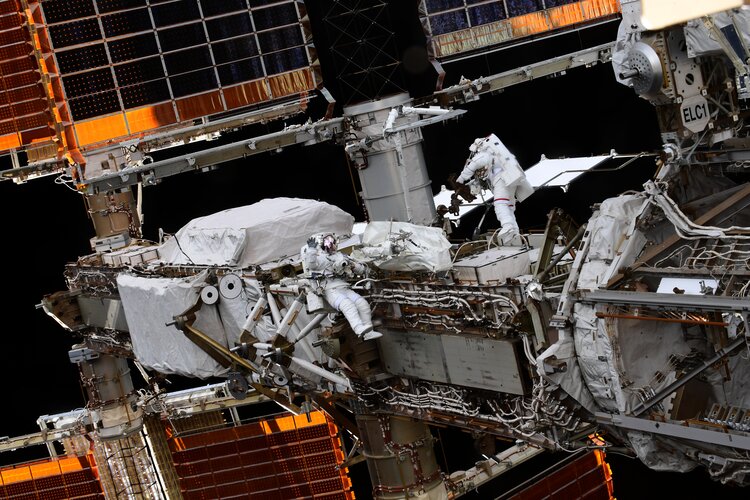
Copernical Team
SpiderOak wins second Air Force contract for secure space communications
 The U.S. Air Force has approved an approximately $750,000 Small Business Innovation Research grant to SpiderOak to test its new OrbitSecure secure communications protocol on military satellites and ground stations. The outcome will enable government agencies to leverage commercial space assets for federal missions in emerging hybrid space architectures that mix commercial and government satellit
The U.S. Air Force has approved an approximately $750,000 Small Business Innovation Research grant to SpiderOak to test its new OrbitSecure secure communications protocol on military satellites and ground stations. The outcome will enable government agencies to leverage commercial space assets for federal missions in emerging hybrid space architectures that mix commercial and government satellit NATO Air and Space Power - Taking the Alliance into 2030
 From Sept. 7-9 the Joint Air Power Competence Centre (JAPCC) hosted their annual Conference convening the NATO Airpower community at Essen, Germany. The presentations and discussions were focused on the topic of Delivering NATO Air and Space Power at the speed of relevance.
"The annual JAPCC conference provides an outstanding opportunity to address the significant challenges of bringing po
From Sept. 7-9 the Joint Air Power Competence Centre (JAPCC) hosted their annual Conference convening the NATO Airpower community at Essen, Germany. The presentations and discussions were focused on the topic of Delivering NATO Air and Space Power at the speed of relevance.
"The annual JAPCC conference provides an outstanding opportunity to address the significant challenges of bringing po Rerun of supernova blast expected to appear in 2037
 It's challenging to make predictions, especially in astronomy. There are however, a few forecasts astronomers can depend on, such as the timing of upcoming lunar and solar eclipses and the clockwork return of some comets.
Now, looking far beyond the solar system, astronomers have added a solid prediction of an event happening deep in intergalactic space: an image of an exploding star, dubb
It's challenging to make predictions, especially in astronomy. There are however, a few forecasts astronomers can depend on, such as the timing of upcoming lunar and solar eclipses and the clockwork return of some comets.
Now, looking far beyond the solar system, astronomers have added a solid prediction of an event happening deep in intergalactic space: an image of an exploding star, dubb Quasars as Cosmic Standard Candles
 In 1929, Edwin Hubble published observations that galaxies' distances and velocities are correlated, with the distances determined using their Cepheid stars. Harvard astronomer Henrietta Swan Leavitt had discovered that a Cepheid star varies periodically with a period that is related to its intrinsic luminosity. She calibrated the effect, and when Hubble compared those calculated values with his
In 1929, Edwin Hubble published observations that galaxies' distances and velocities are correlated, with the distances determined using their Cepheid stars. Harvard astronomer Henrietta Swan Leavitt had discovered that a Cepheid star varies periodically with a period that is related to its intrinsic luminosity. She calibrated the effect, and when Hubble compared those calculated values with his New research takes us closer to figuring out supermassive black holes
 Galaxies host supermassive black holes, which weigh millions to billions times more than our Sun. When galaxies collide, pairs of supermassive black holes at their centres also lie on the collision course. It may take millions of years before two black holes slam into each other. When the distance between them is small enough, the black hole binary starts to produce ripples in space-time, which
Galaxies host supermassive black holes, which weigh millions to billions times more than our Sun. When galaxies collide, pairs of supermassive black holes at their centres also lie on the collision course. It may take millions of years before two black holes slam into each other. When the distance between them is small enough, the black hole binary starts to produce ripples in space-time, which Space Babes
 Houston, we have a problem! Love and sex need to happen in space if we hope to travel long distances and become an interplanetary species, but space organizations are not ready.
National agencies and private space companies - such as NASA and SpaceX - aim to colonize Mars and send humans into space for long-term missions, but they have yet to address the intimate and sexual needs of astron
Houston, we have a problem! Love and sex need to happen in space if we hope to travel long distances and become an interplanetary species, but space organizations are not ready.
National agencies and private space companies - such as NASA and SpaceX - aim to colonize Mars and send humans into space for long-term missions, but they have yet to address the intimate and sexual needs of astron Two astronauts return to ISS after 7-Hour Spacewalk
 Two international astronauts, Japan's Akihiko Hoshide and France's Thomas Pesquet have returned safely to the International Space Station (ISS) after completing a spacewalk that spanned nearly seven hours, NASA said.
"Astronauts Akihiko Hoshide of the Japan Aerospace Exploration Agency (JAXA) and Thomas Pesquet of ESA (European Space Agency) have concluded the first spacewalk conducted by
Two international astronauts, Japan's Akihiko Hoshide and France's Thomas Pesquet have returned safely to the International Space Station (ISS) after completing a spacewalk that spanned nearly seven hours, NASA said.
"Astronauts Akihiko Hoshide of the Japan Aerospace Exploration Agency (JAXA) and Thomas Pesquet of ESA (European Space Agency) have concluded the first spacewalk conducted by Space men at work
 Image:
Image:
If you are spacewalking and you know it, raise your hand.
ESA astronaut Thomas Pesquet (left) and JAXA astronaut Aki Hoshide (right) performed a spacewalk on Sunday 12 September to prepare another section of the International Space Station for its solar panel upgrade.
The new solar arrays, called IROSA or ISS Roll-Out Solar Array, are being gradually installed over the existing arrays to boost the International Space Station’s power system.
Thomas and NASA astronaut Shane Kimbrough prepared and installed two IROSA solar panels across three spacewalks in June. The arrays were taken from their storage area outside the Space Station and
There's now a gas station in space

According to the Union of Concerned Scientists (UCS), over 4,000 operational satellites are currently in orbit around Earth. According to some estimates, this number is expected to reach as high as 100,000 by the end of this decade, including telecommunication, internet, research, navigation, and Earth Observation satellites. As part of the commercialization of low Earth orbit (LEO) anticipated in this century, the presence of so many satellites will create new opportunities, as well as hazards.
The presence of these satellites will require a great deal of mitigation to prevent collisions, servicing and maintenance. For example, the San Francisco-based startup Orbit Fab is working to create all the necessary technology for orbital refueling services for satellites. To help realize this goal, industry giant Lockheed Martin recently announced that they are investing in Orbit Fab's "Gas Stations in Space" refueling technology.
The San Francisco-based startup was founded in 2018 by Daniel Faber and Jeremy Schiel, both of whom have strong backgrounds in the commercial space industry. Between 2016 and 2019, Faber was the CEO of Deep Space Industries (DSI), one of the leading companies currently developing asteroid mining capabilities.
Announcing Earth observation hackathon winners

In June 2021, more than 4300 participants from 132 countries and territories came together to solve challenges related to the COVID-19 pandemic. ESA, NASA and the Japan Aerospace Exploration Agency (JAXA) are pleased to announce CleverChart and TRACER as the winners of the Open Science Award.
